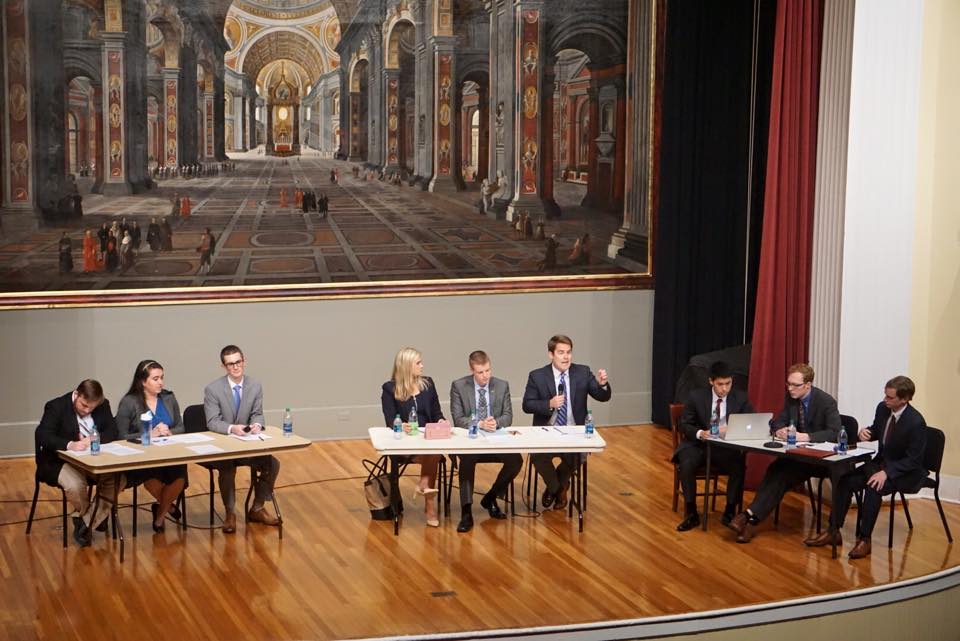By Alex Edquist
On November 4, Georgia Political Review hosted the fourth annual Great Debate between the University of Georgia’s Young Democrats and College Republicans. Both sides, at least to this writer, seemed better-informed than many of the actual presidential candidates (but we always knew that UGA students were smart). However, the debaters did make a few claims that begged for fact checking, and in the spirit of keeping our readers informed, we did just that!
When debating gun violence, both sides used Australia’s 1996 gun agreement as evidence for their arguments. In 1996, Australia suffered the Port Arthur massacre, a mass shooting that left 35 dead and 23 wounded. In response, Australia greatly restricted ownership of self-loading guns (like semi-automatic rifles) and implemented a buy-back program. The Young Democrats claimed that gun violence was reduced by 43 percent as a result of this law. While I couldn’t find a source for the specific “43 percent” number, PolitiFact checked a very similar claim and rated it Mostly True. Stephen King (author of The Shawshank Redemption and The Shining) claimed that Australia’s gun laws and buybacks reduced firearm homicides by 60 percent. Most academic studies find a reduction in this range, although there are two complicating factors: gun violence was already on the decline in Australia when the laws were implemented, making a causal relationship more difficult to establish, and firearm homicides are relatively low in Australia, making it difficult to find statistically significant effects. However, I won’t quibble with the fact-checking experts here. The Democrats get a Mostly True rating for this one.
I wanted to fact-check the Republicans’ claim that an Australian-esque gun buyback program would violate the Second Amendment, but unfortunately Chief Justice John Roberts didn’t respond to my email.
Both parties also made some strong claims when we got to climate change. The Democrats said that Obama got China to reduce its emissions; the Republicans countered that China was already burning twice as much coal as it had agreed to.
Who was right? Well… neither. In the lauded U.S.-China emissions deal, China agreed to cap its carbon emissions at their peak in 2030 with the intention of peaking before then. So, China didn’t agree to reduce its emissions like the Young Democrats claimed; rather, it agreed to reduce its emissions after this 2030 peak. This agreement was criticized because it seems like China is not required to do anything before 2030, but China will actually have to impose many changes to peak its emissions in 2030 (in September this year, it announced plans for a national cap-and-trade program). China also never agreed to a specific level of emissions it would reach in 2030, so the College Republicans’ claim that it’s burning twice as much coal as agreed doesn’t make sense (although it was recently revealed that China was burning more coal than it previously claimed). Because both claims were technically wrong but were in the right direction in spirit, they both get Mostly False ratings.
Towards the end of the debate, the College Republicans said for a second time that they were “not the party of old white people.” Pointing to presidential candidates, they’re correct. Their claim that three of the four leading Republican presidential candidates are minorities was also correct. According to most recent polls, Ben Carson, who is black, is polling first or second, and Marco Rubio and Ted Cruz, both Hispanic, are third and fourth. Rubio and Cruz are also both in their forties, while Hillary Clinton is 68 and Bernie Sanders is the oldest presidential candidate at 74 years old (Trump is 69 and Carson is 64).
However, outside of the presidential race, the Republican Party is still the one of white people (although not necessarily of old white people). In Congress, there are 81 Democrats who are minorities but only 16 Republicans. However, the average Congressional Democrat is older than the average Congressional Republican (although the average age of both parties is the highest it’s ever been).
Then, of course, there are the voters themselves, and here the Republican Party truly is the party of old white people. The majority of white voters have been Republican in recent years while the majority of non-white voters have been Democrat, and the older someone is, the more likely they’re Republican.
In the presidential race, Republicans are neither the party of old people nor white people. In Congress, they are the party of white people but not old people. In the voting population, they are both the party of old people and white people. Therefore, we give the College Republicans a Half True rating on this claim.
And finally, the most important fact check: were the Young Democrats correct when they claimed that people can’t get addicted to marijuana? No, they were not. An estimated nine percent of marijuana users will become addicted, a number that rises to 17 percent of users who started when they were young. However, marijuana is much less addictive than other substances such as ……. An old (1994) study of different drugs showed that marijuana was among the least addictive compared to other substances like heroin, nicotine, and cocaine (one researcher even ranked marijuana as less addictive than caffeine).
While it is possible to become addicted to marijuana, no one has ever died of a marijuana overdose, something that few drugs can claim.
Because addiction is a small but significant risk of marijuana use, I rate the Young Democrats’ claim Mostly False.We sent these claims over to both the Young Democrats and the College Republicans for responses before publishing this article. The Young Democrats’ only response was to ask for fact-checking on the Planned Parenthood claims both sides made on the debate. During the debate, the College Republicans claimed that Planned Parenthood doesn’t provide essential services for men and women, while Young Democrats claimed that only 3% of Planned Parenthood’s services are abortion, while the other 97% are essential services. So who was correct? Young Democrats’ 3% claim checks out, but the two groups seem to be defining “essential services” differently, which is why we did not initially fact check these claims. We’ll leave it up to our readers to decide if providing things like STD screening and contraception (Planned Parenthood’s biggest two categories) count as “essential services” or not.
The College Republicans had no comments to add to this article.
Photo: Georgia Political Review


